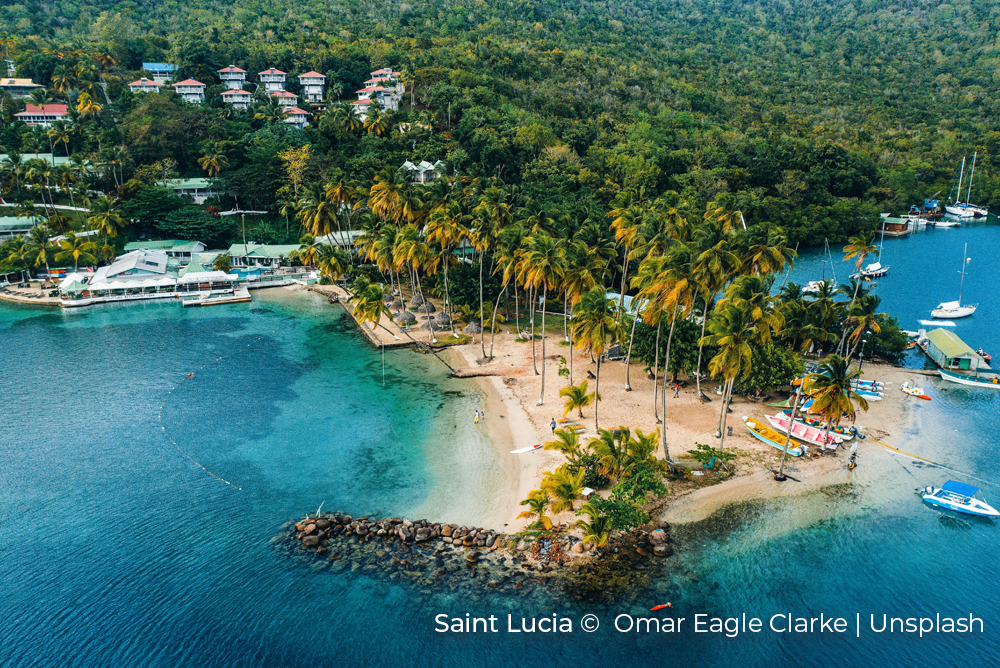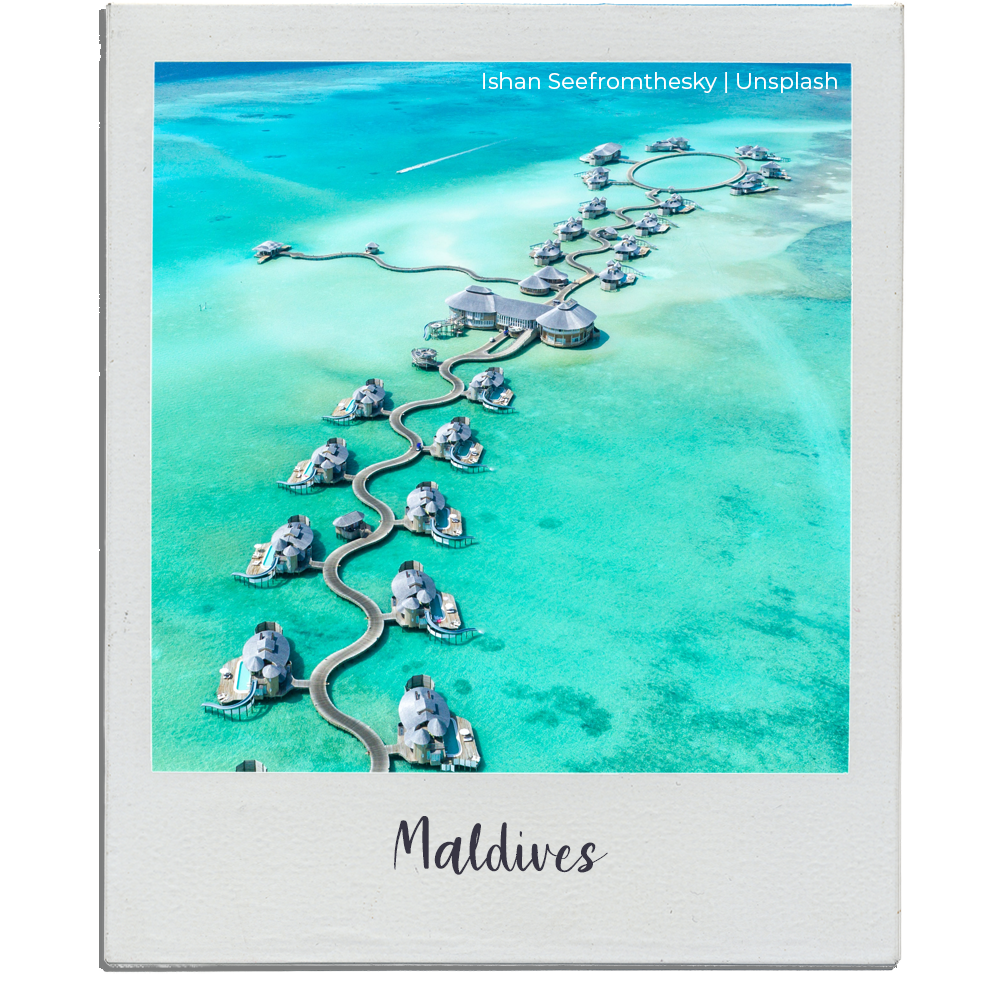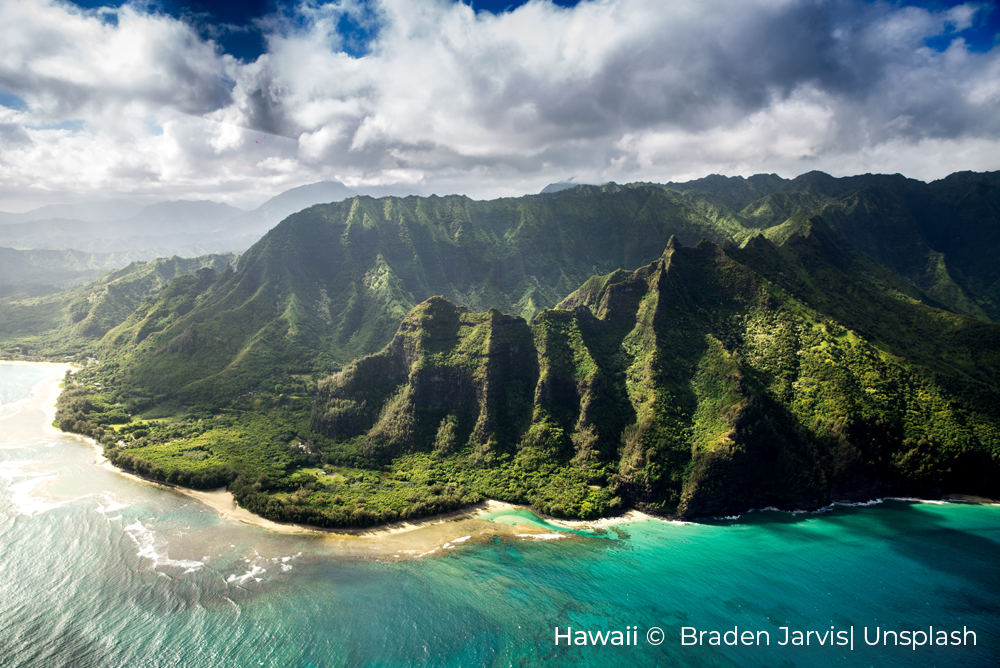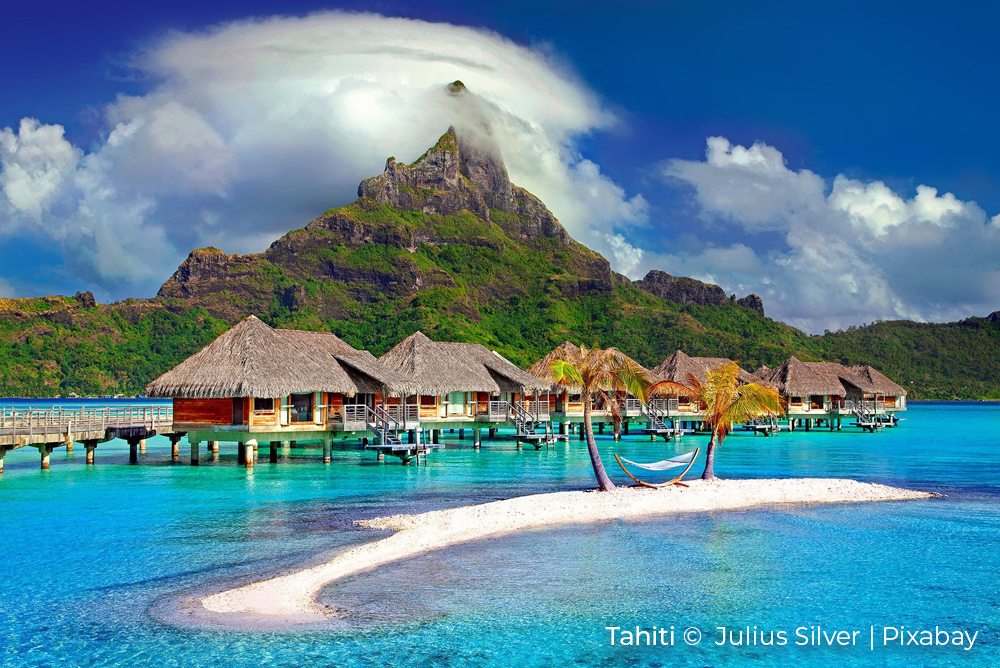
Are you dreaming of an island escape? Well it looks like they will feature heavily on the government’s green list. Join us for a whistle-stop tour of some of world’s best
This is an article from Issue 5. To read other articles from this issue please click the button below.
What is it about islands that is captivating to humans? Certainly, the idea of being cut off from the ‘real word’ is appealing in modern times. But our fascination with islands goes much further back; they have been romanticised in art and literature for centuries.
No wonder adults dream of island escapes, there are dozens of children’s books in which an island is as important as the protagonists – from the idyllic tropical castaway depicted in The Swiss Family Robinson to the savagery of isolation in Lord of the Flies, with a whole host of adventurous idylls in between.
Radio Four’s Desert Island Discs programme asks its famous guests to choose eight records, a book and a luxury which they would take if they were to be marooned and it’s a question that is endlessly fascinating for listeners because it’s been running since 1942.
Writer Gavin Francis explores the collective fascination with islands in his book, Island Dreams, mapping an obsession. He uncovers many reasons to hanker after island life, revealing them as catalysts for self-reflection and transformation; inspiration and awe; isolation and peace.
Leaving the romantic notions of islands aside, there is one very strong reason to recommend islands for a holiday right now. Thanks to their natural geographic isolation, many island nations have fared well in the pandemic, with low infection rates and successful track records of handling what cases do arrive.
The government’s green list demonstrates this by including several, ranging from the isolated extremes of St. Helena to easier to reach rugged archipelagos like the Azores (see page 76). It’s likely that more islands will follow as the list is revised so, in anticipation of this, we wanted to offer some snap-shot inspiration for your next island escape.
Africa
Islands don’t spring to mind when you think of Africa but dotted all around the continent there are some of the world’s most alluring. Rising from the Atlantic, around 300 miles west of Senegal, Cape Verde is an island chain with a collection of landscapes that don’t seem to belong together – wildflower covered mountains and ashen volcanic plateaus within and dreamy beaches on the edge. Floating off the Sahara are the politically Spanish Canary Islands, mixing Saharan sand dunes with pine forests, lava fields and cacti-sprinkled plains. Off Egypt and Eritrea are Red Sea islands marking underwater marine parks of dazzling biodiversity while the islands of Kenya and Tanzania are ancient trading posts where exotic cultures crossed and still remain.
Classics: Kenya’s Lamu Island has gorgeous beaches and sapphire seas as well as being a centre of Swahili and Islamic culture for over 700 years. Madagascar is an ex-French colony home to rare and wonderful creatures seen nowhere else on earth – like the lemur. Zanzibar, off the coast of Tanzania, is where Africa meets Arabia, with idyllic beaches, fields of rice and cloves and the ancient trading port of Stone Town.

Hidden gems: Atlantic Principe is a lush island of crumbling old cocoa plantations and deserted banana-coloured beaches. Rubondo Island on Lake Victoria in Tanzania is home to chimpanzees, forest elephants, giraffe and rare antelope. Mozambique’s Bazaruto Archipelago has four islands blessed by pale sand beaches, wild orange and cashew trees and a marine park home to dugongs.

Asia
Indonesia and the Philippines are home to approximately 17,000 and 7,000 islands respectively, ranging from Java, which is the world’s most populous island, to tiny Bohol which is home to the world’s smallest primate, the goggle-eyed tarsier. Islands like Langkawi in Malaysia and Koh Samui in Thailand are home to numerous luxury resorts, while the stunning limestone outcrops and lagoons of Indonesia’s Raja Ampat Islands have just basic homestays and a handful of dive resorts. But it’s the cultural and bio-diversity of Asia’s islands which stands out.
Classics: Shared between Malaysia, Indonesia and Brunei, Borneo is one of the most biodiverse islands on the planet, its thick forest and rivers hide orangutans pygmy elephants, clouded leopards and saltwater crocodile. Hedonistic and hippy Koh Pha Ngan in the Gulf of Thailand is famous for its full moon parties and silky beaches. Bali is a frangipani-fragranced paradise of golden and black sand beaches, temples and terraced rice paddies.
Hidden gems: The Philippines’ Siquijor Island is famous for its mountain-dwelling healers as well as its beautiful white-sand beaches, caves and waterfalls. Japan’s Taketomi Isand is culturally significant for its traditional houses with red tiled roofs and its roads of crushed coral are plied by buffalo carts. Havelock Island in India’s Andaman Islands boasts platinum beaches and pristine mangroves, forest and coral reefs.
The Caribbean
The Caribbean is practically an adjective for tropical paradise. Most travellers go for the beaches and renowned resorts but return for the laid-back culture. You can see Dutch architecture in Aruba, Spanish casas in Cuba, French restaurants in Martinique and British red phone boxes in Grenada. The region is the home of reggae music, while many islands have their own annual carnival or all have a hotspot for its most popular pastime – ‘liming’, which simply means hanging out.
While the beaches are legendary – Antigua alone has one for every day of the year – that’s not all there is to impress. You can windsurf in Barbados, jungle trek in Puerto Rico, snorkel with turtles in Curacao, explore crumbling colonial plazas in the Dominican Republic or climb a volcano on St. Kitts.

Classics: Saint Lucia’s Pitons, its pointed peaks smothered in greenery, are its crowning glory. The biggest island in the Caribbean, Cuba invented the mojito and its time capsule capital Havana is one of the world’s most atmospheric. Barbados has blissful beaches, a UNESCO-rated capital and one of the most legendary Friday night parties in the world, at Oistins Fish Fry.
Hidden gems: Dominica is known as the nature island thanks to its jungle-clad mountains with bubbling hot pools. Montserrat was famously devastated by a volcanic eruption in the 90s but is a nature lover’s paradise with a surprising slice of Irish culture. Little Cayman has a population of less than 200 and its capital is called Blossom Village, where you go to get away from it all.

Europe
The islands of Europe are certainly diverse, ranging from the arctic wilds of Svalbard, stalked by polar bears, to sun-scorched Mediterranean isles like Malta.
Sweden, Norway and Finland (in that order) can claim the largest share of islands on the planet, yet how many can you name? Gotland is one. The Swedish island has pretty sandy beaches, sculptural sea stacks and the remarkably preserved town of Visby, dating back to the 12th century.
Classics: Ibiza has it all – white-washed towns of tapas bars, legendary nightlife and quiet beaches and hilltop villas where you can recover. Santorini’s sheer cliffs topped with blue-domed villas marooned in the deep blue Aegean are quite simply iconic. Croatia’s Hvar boasts impossibly clear sea lapping its pebble beaches, while inland are lavender fields and terracotta-tiled villages.
Hidden gems: Visiting Saaremaa in Estonia is like stepping back in time, its quaint little villages are swaddled in fragrant forests of pine, spruce and juniper. Around ten people live year-round on Faroese island Mykines, protected by its turf-roofed houses and accompanied by flocks of puffins who nest on its dizzying cliffs. The smoking volcanic mount of Stromboli off the coast of Sicily inspired J.R.R. Tolkein’s Mordor and its ashen slopes contrast with the whitewashed villas festooned with bougainvillea.
Latin America
This diverse region stretches between hot and cold extremities. Down south, the British territory and penguin paradise of the Falkland Islands will appeal as much to history buffs as to nature enthusiasts. At the hotter end of the scale, the islands of Mexico’s Sea of Cortez are legendary amongst divers, with Jacques Cousteau famously calling it ‘the world’s aquarium’. It’s also got some of the most remote but sought after islands in the world – Ecuador’s Galapagos, famous for their incredible biodiversity, and Chile’s barren Easter Island, which has long had a mystical allure thanks to its monumental and enigmatic statues.
Classics: Nicaragua’s Caribbean Corn Islands are famous for Creole culture, diving and pristine beaches; Ambergris Caye is Belize’s biggest island, where you can snorkel the world’s second-largest barrier reef. Ilha Grande is a popular getaway for Rio de Janeiro natives, a car-free zone of forest and stunning beaches.

Hidden gems: Chile’s Chiloe archipelago is famous for its colourful wooden houses on stilts and lush green forests. Omotepe is a twin-volcano island in the middle of Lake Nicaragua, verdant and unspoilt. Colombia’s rocky Malpelo Island is loved by divers for the proliferation of sharks that patrol its underwater world.

The Middle East and Indian Ocean
While Dubai is famous for its artificial islands, home to mega resorts, there are more islands around the Arabian peninsula. Abu Dhabi’s Sir Bani Yas is home to Arabia’s largest nature reserve and flocks of flamingos.
The islands of the mid-Indian Ocean were barely known by British travellers 5o years ago but have since become synonymous with barefoot luxury thanks to a proliferation of five-star resorts, most notably in the barely-there desert isles of the Maldives
Classics: The author Mark Twain said that heaven was copied from Mauritius, a vertiginous isle bursting with beaches and botanical delights and mixing French, Indian, African and Arabic culture. Almost every resort in the Maldives is its own private island ringed by pristine white sand and swaying palms. Praslin is the Seychelles’ most photographed island, thanks to its silken sand beaches backed by granite boulders and a forest home to rare bottom-shaped coconuts.
Hidden gems: Reunion is Mauritius’ drama queen sister, a black rock ringed by beautiful beaches and an interior of emerald forests, waving sugar cane and a rumbling volcano. Socotra is an almost mythical island belonging to Yemen, famed for its surreal looking dragon blood trees, canyons and giant sand dunes. Oman’s Dimaniyat Islands Nature Reserve protects a large number of sea turtles and rare birds.
North America
Frozen Alaska and tropical Hawaii couldn’t be more different but they have an abundance of islands in common. Alaska’s Kodiak Island is home to as many as 3,000 of the largest grizzly bears in the world while Hawaii’s Maui is pounded by the biggest waves on the planet and inland and its diverse interior ranges from lush bamboo forests to the Mars-like Haleakalā National Park.
Canada has countless islands. From Vancouver Island on the Pacific, where totem poles peek out from moss-smothered forests, to Prince Edward Island on the Atlantic, where red cliffs and white sand beaches surround a bucolic farmland interior, the setting for Anne of Green Gables.

Classics: Florida’s Sanibel is visited for its dazzling shell-strewn beaches nosed by dolphins. Sitting off San Francisco, Alcatraz or ‘The Rock’ was home to a notorious penitentiary that housed prisoners including Al Capone. Nantucket Island in Massachusetts is loved for its pretty lighthouses, vineyards, beaches and clapboard houses.
Hidden gems: Jekyll Island in Georgia has bone-white beaches, atmospheric forests of live oaks dripping in Spanish moss and a grand hotel which was once the world’s most exclusive club. Manitoulin Island, the largest freshwater island in the world, is located in Lake Huron, Ontario and is rich in indigenous culture. California’s five Channel Islands are a national park famous for whale watching and rugged clifftop hikes.

The Pacific
Most of the islands in the Pacific are barely specks on the map, but zoom in and you’ll find that these scattered pearls over the world’s largest ocean each have their own unique personality. In Fiji you’ll find Hindu temples and curry houses, while the French heavily influence Tahiti’s gastronomic delights. Tonga is a proud kingdom where Christian churches abound, where as New Guinea is a patchwork of tribes, many of which are far-removed from the modern world. What they all have in common is mesmerizingly fertile nature above and below the water.
Classics: French Polynesia’s five island groups range from the fecund mountains of Tahiti to the flat castaway atolls and lagoons of the Tuamoto islands. Fiji’s unhurried culture matches perfectly with its exquisite desert islands and sultry jungles. The Cook Islands’ Aitutaki is one of the world’s most sublime lagoons, lined with tiny deserted islands, or motus.
Hidden gems: New Caledonia is a sophisticated French enclave where desert islands have pine trees and cowboys work an outback-style style landscape with red earth. The volcanic islands of Vanuatu are where a visiting New Zealander got the idea for bungee jumping from the locals, who leap from jungle platforms with tree roots tied to their ankles. Samoa was birthed by a series of volcanic explosions which created fertile jungles and intriguing features, like the To Sua Ocean Trench, a deep natural swimming pool surrounded by jungle.
This is a feature from Issue 5 of Charitable Traveller. Click below to read more from this issue.

















 by net effect
by net effect